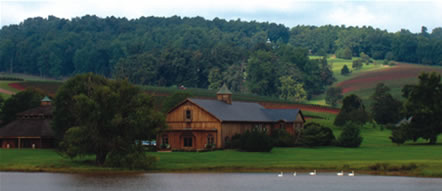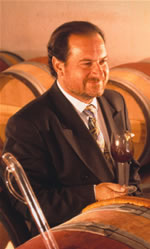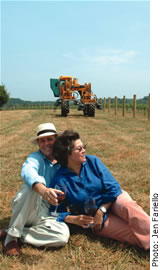
|
|
PRINT » |
|
|
E-MAIL THIS PAGE » |
|
|
CLOSE THIS WINDOW » |
Feature Article from the March 2007 Magazine Issue
Rolland's Mark on Virginia
The Bordeaux consultant remakes Patricia Kluge's estate

Nestled in the rolling hills south of Charlottesville, Va., Kluge Estate Winery has been replanting its vineyards with a goal of producing world-class wines.
Patricia Kluge has that determination and, thanks to a generous 1990 divorce from her second husband, media mogul John Kluge, the resources to pursue it. In the late '90s, she carved about 900 acres out of her 2,000-acre estate south of Charlottesville, Va., and created Kluge Estate winery. (About 195 acres are currently planted, with another 65 acres to be planted this year.)
Then in 2001, with Kluge Estate about to produce the first vintage of its flagship New World Red, a Bordeaux blend of Cabernet Sauvignon, Merlot and Cabernet Franc, Kluge decided that to make a wine that could stand among the world's best, she needed the help of one of the world's top wine consultants. She flew to France and enlisted Michel Rolland, the globe-trotting "flying winemaker" who consults for more than 100 wineries around the world. Kluge Estate is his only client in the Eastern United States.
Rolland, of course, is controversial, most notably because of "Mondovino," the 2004 documentary by Jonathan Lassiter that portrayed Rolland as some sort of tinkering chemist who instructed his global clients in making wines that would all taste alike. A recent New York Times article summed up the love-him-or-hate-him debate about Rolland's influence with the headline, "Satan or Savior?"
Kluge is unabashedly in the pro-Rolland camp.
"We were very lucky to be in the position to be able to hire the people who can help us from the beginning, when others might not be able to," Kluge says. Rolland consults on the winery's red wines--the New World Red and a second label, Albemarle, called "Simply Red." Kluge Estates also makes an all-Chardonnay sparkling wine, a Viognier and a saignee rosé made from juice bled off from the reds.
In "Mondovino," Rolland was portrayed making lightning-quick visits to wineries to dispense advice on a sniff and a spit, or in the scientific backdrop of his laboratory. But at Kluge Estate, his influence has been primarily in the vineyards rather than the winery.
When Rolland first visited the Kluge vineyards, he asked why the vines were trained so high and planted so far apart. The initial plantings were at 600 to 900 vines per acre, with the vines trained high to guard against potential frost damage. "That's what everyone was telling us to do," Kluge says.
At Rolland's urging, subsequent vineyards were planted at 1,875 vines per acre, with the vines trained lower to the ground, as is more typical in Bordeaux. These bore their first fruit in 2006, and Kluge calls the fruit "superb." The 2007 plantings will increase that density to 2,500 vines, and in 2011, the winery intends to replant the initial vineyards at a density of 3,500 vines per acre.
"Virginia is not new to winemaking, but it is new to making world-class wines. There is no secret to making great wines--it starts with the best viticulture possible to produce the best grapes," Rolland said in an e-mail exchange about his efforts in Virginia. "Quality stems from high-density plantings, low crop yields, old vines and water scarcity. Only after this is achieved can we think about winemaking."
Rolland's emphasis on high-density planting contradicts the advice of the Virginia Tech agricultural extension, which has been influential in shaping Virginia's vineyard practices for the past two decades. Tech's general recommendation (which varies somewhat depending on soil conditions, rootstock, intended trellising and other factors) is to space rows about 9 feet apart, with 6 feet between vines within a row--or about 800 vines per acre, according to Tony Wolf, the extension's viticulturist.
Whether higher vine density leads to improved quality in the wine "remains to be determined," Wolf says. And at $4 per vine, increasing the density dramatically raises the cost of planting an acre. At 600 vines per acre, it's $2,400; at 3,500 vines, $14,000.

Globe-trotting winemaker Michel Rolland consults with Kluge; his most telling influence has been in the vineyards, where he emphasizes high-density planting.
At Barboursville Vineyards, just north of Charlottesville, winemaker Luca Paschina has planted his newest vineyards at 8 feet between rows and 3 feet between vines, for 1,900 vines per acre. Older plantings were at 12 feet between rows and 6 feet between vines, or 643 vines per acre.
The Old Dominion's wine industry is forever linked to Thomas Jefferson's failure to grow European vines at Monticello (which is just around the corner, in a rural sense, from Kluge Estate on Carter's Mountain, just south of Charlottesville), a failure probably due more to phylloxera ravaging ungrafted rootstock than to any unsuitability of Virginia's soil and climate to vinifera grapes. From six wineries in 1979, Virginia's industry has grown to more than 100 today. The state's vignerons have become experienced in dealing with Virginia's fickle climate, which features summer humidity and a propensity for autumn rains. And they have learned which grape varieties and clones grow best on various parcels of land. But those lessons are not easily implemented if resources are scarce; many Virginia wineries are still living with the mistakes of their past.
Is there a Virginia terroir? "There is always a terroir, even in emerging winemaking regions," Rolland says. "Our job is to find the limit. The only problem we have in Virginia is the weather. No one year is similar to another, but we can still find a wonderful balance in the wines every vintage."
One impact of Virginia's uncertain fall climate is ripeness. Cabernet Franc has been popular with growers because it ripens earlier than Cabernet Sauvignon. At Barboursville, Paschina is planting new vineyards with Cabernet Sauvignon Clone 337, which he says ripens an average of 10 days earlier than the Cabernet he planted a decade ago before clonal research was so advanced; 337 also has smaller berries and more clusters, contributing to greater intensity of color, another problem typical of Virginia red wines.
To achieve full ripeness and phenolic maturity, Rolland counsels Kluge Estate to leave grapes on the vine even while its competitors have begun to harvest. This is not, however, the "hang time" question that has become controversial in California's hotter, drier climate. "In Virginia, reds are typically picked at 21 to 22º Brix," Kluge says. "For us, depending on each vineyard and its microclimate, we pick between 22 to 23º Brix.
"When you think the grapes are ready to harvest, (Rolland) tells us to wait," Kluge says. "It's very nerve-wracking."

William Moses and Patricia Kluge enjoy their vineyard. Moses is CEO of the winery, and believes the Virginia wine industry is just now on the brink of success.
Rolland visits Virginia several times a year to consult with Kluge Estate, but even when he's not there, communication over the Internet helps him watch the vines' progress. September 2003 was rainy, with a tropical storm saturating the mid-Atlantic region--that year, Kluge Estate "declassified" its New World Red and made only the Albemarle Simply Red.
Weather posed a challenge again in 2006, when August and September vacillated between extreme heat and rain, but photos sent by e-mail to France prompted quick advice from Rolland about tending the vines. Grape samples couriered overnight to Rolland's lab in Bordeaux also kept his team up to date on the condition of the fruit.
"Because the weather was precarious this year, we left the leaves on longer than we would have otherwise," Kluge says, crediting Rolland with that advice.
For the long term, Rolland's goal at Kluge Estate is to unlock the potential of the Carter Mountain soil. Winemaker Charles Gendrot, whose father Gérard is a consultant in Bordeaux and a competitor of Rolland, calls the red clay of the area "pure gold," if used correctly.
"Our job," Charles Gendrot says of himself and Rolland, "is not just to repeat some déjà vu from Bordeaux or elsewhere on the planet, but to release this mountain, these micro-crus. We have a thousand different terroirs here--one detail, perhaps the flow of wind through the trees, will change and have an impact on the wine."
William Moses, Kluge Estate's CEO and Patricia Kluge's husband, describes the Virginia wine industry as being at "the tipping point" of success: With more than 100 wineries and 4,000 acres planted statewide, the industry is poised to expand to 200 wineries and 10,000 acres, he predicts. He cites favorable geography, with the Blue Ridge Mountains providing some cover against weather patterns from the west and a favorable political climate in Virginia, as factors in his optimism.
"If you were looking to buy vineyard land, where would you go?" asks Moses, a former executive with IBM and the National Football League. "We are within 500 miles of two-thirds of the population of the U.S., about a one-hour flight to the major markets of New York and Atlanta."
Moses says Kluge Estate, with its resources, determination and impatience, hopes to be "the rising tide" that will lift Virginia's wine industry. But he acknowledges that Rolland's influence on Kluge Estate's wines will raise questions among skeptics, including the somewhat contradictory arguments that his main contribution is to lend his prestige to the winery's marketing or, on the other hand, to make Kluge Estate wines taste like some generic international model.
"We are aware of the 'Mondovino' critique"--that Rolland counsels his clients to make wines that taste alike without relation to where they are made, he says. "But we don't think it holds here. People can misunderstand Michel's role. He's a consultant, but it is our winery."
Moses declines to divulge how much Kluge Estate pays Rolland for his services. But, he says, "Given the time and attention he gives us, and the advice he's given us, I'd say his fees are not unreasonable."
Kluge herself disputes the Rolland critique in earthier language.
"Michel Rolland has been accused of making the same wine all over the world," she says. "That's like saying if a man sleeps with different women, all his children will look alike. Every region is a different woman, which has its own elevation, its own climate and its own soil.
"So while everybody knows he's the father," Kluge says, "all the children are different."
(Based in Silver Spring, Md., Dave McIntyre has published Dave McIntyre's WineLine on the Internet since 1999. He is currently the restaurant reviewer and wine and spirits columnist for Modern Luxury's DC. His writing has appeared in Win e Enthusiast, the San Francisco Chronicle, decanter.com, The Washington Post and many other publications. Reach him or comment on this article at edit@winesandvines.com.)
|
|
PRINT » |
|
|
E-MAIL THIS ARTICLE » |
|
|
CLOSE THIS WINDOW » |
